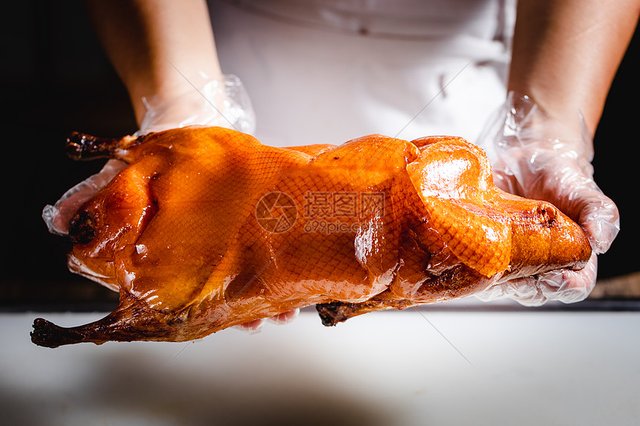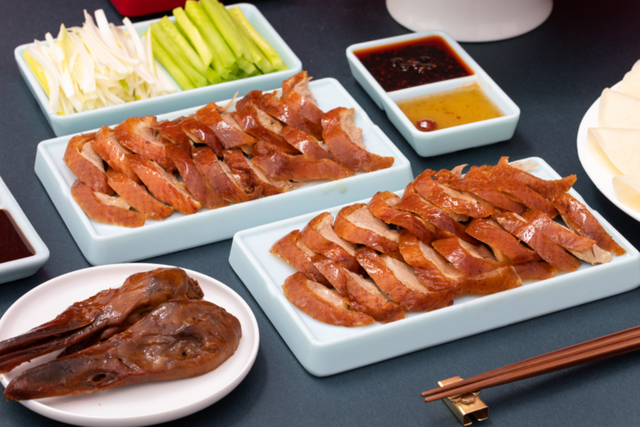Chinese Cuisine: Beijing Roast Duck
Historical Origin
Beijing Roast Duck has a long history, with various theories about its origin, among which the "Nanjing Origin Theory" is more credible. It is said that after Zhu Yuanzhang (the Hongwu Emperor of the Ming Dynasty) established his capital in Nanjing, imperial chefs developed the roast duck technique. When Zhu Di (the Yongle Emperor) moved the capital to Beijing, he brought this craft to Beijing, which later spread to the public.
In 1416, "Bianyifang"—Beijing's first roast duck restaurant—opened, using the closed-oven technique. In 1864, "Quanjude" opened, using fruit wood (such as jujube and pear wood) as fuel and the open-oven roasting method, further advancing the roast duck craftsmanship.
Production Process
Duck Selection: Beijing filler ducks with tender and plump meat are typically chosen, raised to a specific weight and age to ensure the quality and texture of the duck meat.
坯 Preparation (坯:坯体,carcass): The duck undergoes multiple processes including slaughter, scalding, plucking, evisceration, and cleaning. A small hole is made in the duck's body to remove internal organs, after which boiling water is poured into the belly, and the hole is tied up.
Drying the Carcass: The processed duck carcass is hung in a ventilated place to dry, allowing the surface moisture of the skin to evaporate, which ensures the skin becomes crispy during roasting.
Roasting: There are two main schools:
Closed-Oven Roasting: The duck is roasted without direct fire. Straw and other fuels heat the oven to an appropriate temperature, after which the fire is extinguished. The duck carcass is placed on an iron cover in the oven, and the door is closed for 焖烤 (braised roasting).
Open-Oven Roasting: The oven has holes but no door, using open fire from fruit wood (jujube, pear, etc.). During roasting, the duck is repeatedly exposed to the flames to ensure even coloring, uniform ripening, crispier skin, and a fruity aroma from the wood.
Flavor & Texture
Crispy Skin: After special roasting, the skin turns golden and crispy, making a "crunch" sound when bitten. This crispness, a hallmark of Beijing Roast Duck, is utterly addictive.
Tender Meat: The meat remains juicy and tender, with a delicate texture that melts in the mouth. The contrast between the crispy skin and tender meat creates a rich, layered taste.
Aromatic Flavor: The fragrance of fruit wood penetrates the meat during roasting, imparting a unique fruity aroma. Paired with the sweet-salty bean paste, pungent scallions, and refreshing cucumber, the flavors blend harmoniously, leaving a lingering aftertaste.
Serving Method
Traditional Accompaniments: The freshly roasted duck is sliced into thin pieces, served with paper-thin lotus leaf pancakes, sweet bean sauce, scallion shreds, and cucumber strips.
How to Roll: Take a pancake, spread bean sauce evenly, place several slices of duck meat, add scallion and cucumber shreds, then roll the pancake gently. The mixed flavors of ingredients create a burst of deliciousness in every bite.
Cultural Significance
Beijing Roast Duck is not just a dish but a symbol of Chinese food culture, hailed as a masterpiece of the Chinese culinary heritage and known as "the world's delicacy." It enjoys global renown.
It often appears at important banquets, serving as a signature dish for entertaining foreign heads of state, government officials, and distinguished guests. It is a must-try for visitors to Beijing, embodying the cultural identity of both Beijing and China.

